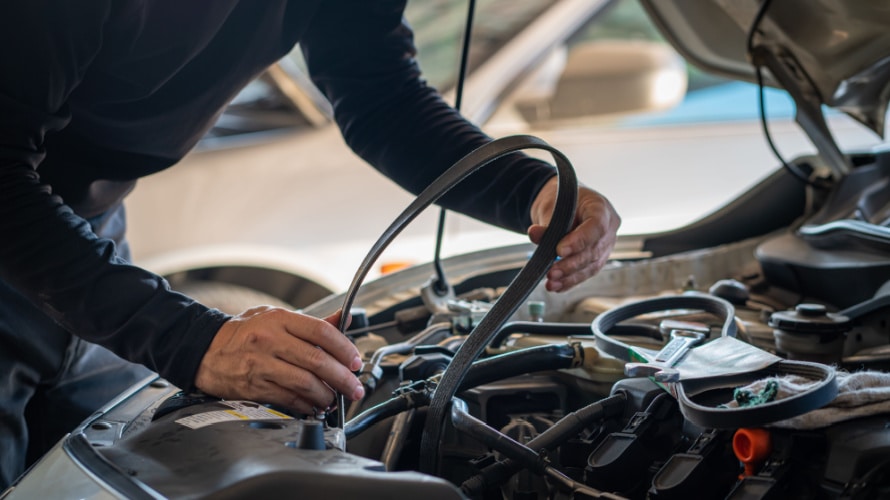Decoding The Mystery Of Timing Belts: Expert Advice From TIRECRAFT Techs
October 30, 2023
Tires

What Is A Timing Belt?
Your vehicle’s timing belt is an important part of your engine. This belt controls the timing and synchronization of the engine’s internal components. It’s a flexible, toothed belt which is most often made of rubber and reinforced with cords or fibers.
The timing belt ensures that the camshaft and crankshaft, rotate in perfect cooperation. The camshaft and crankshaft control the piston movements, and the intake/ exhaust valves. Timing belts are a key feature of internal combustion engines, but they are not present in the battery-powered engines of electric vehicles.
How A Timing Belt Works
An engine’s timing belt connects the camshaft and crankshaft. The camshaft opens and closes the engine’s intake and exhaust valves. It must operate in precise coordination with the engine’s pistons. The crankshaft connects to the pistons and converts the up-and-down motion of the pistons into rotational motion.
The job of a timing belt is to ensure that the camshaft and crankshaft work together, turning at the same rate in perfect synchronicity. This synchronization is crucial as it determines when the engine’s valves open and close in relation to the position of the pistons. Proper timing is essential for efficient and reliable engine operation.
The Importance Of The Timing Belt
It’s easy to overlook how complex our vehicles are. Apart from potentially the transmission, the engine is the most complex of all the components, especially on a gasoline- or diesel-powered vehicle. If the timing belt fails or breaks, the engine’s valves and pistons will fall out of sync. This can lead to serious engine damage. If the valves collide with the pistons, the valves can bend, the pistons will incur damage, and these problems can lead to full engine failure.
How To Care For Your Timing Belt
To prevent catastrophic engine failures, it’s important to follow your auto manufacturer’s recommended maintenance schedule. This is true for all your engine and automobile maintenance, and it includes replacing your timing belt at the intervals your owner’s manual specifies. For most vehicles, this interval is about every 95,000 to 160,000 kilometres.
The interval for your vehicle depends on the type of engine it has and the type of timing belt used. Some vehicles use timing chains, which have different maintenance requirements. Replacing your timing belt regularly helps ensure that your engine operates at optimal levels and can help you avoid costly repairs.
Signs Of A Bad Timing Belt
There are some ways you can tell if the timing belt in your engine is damaged or worn down. Recognizing the symptoms of a failing timing belt can be critical for preventing further engine damage. Here are some common symptoms of a damaged timing belt:
Engine Misfires
If the timing belt has skipped a few teeth or if it has suffered some other form of damage, it can cause the engine’s timing to be off. This misalignment can result in engine misfires, where the air-fuel mixture is not properly ignited, leading to rough idling and poor performance.
Odd Noises
A damaged timing belt might cause your engine to make unusual ticking or clicking noises. This noise is often caused by the belt slapping against the timing cover or other engine components.
Difficulty Starting
A worn or damaged timing belt can lead to starting difficulties. The engine’s timing may be too far off for it to start properly.
Loss Of Power
As the timing belt wears out or gets stretched out, it can hinder the engine’s performance. This can lead to a noticeable loss of power and acceleration.
Rough Idling
An engine with a failing timing belt may idle roughly, causing the vehicle to vibrate or shake when you’re not moving.
Engine Stalls
If your timing belt breaks entirely, your engine is likely to stall, and your vehicle won’t run. This would, obviously, necessitate immediate attention.
Warning Lights
Your dashboard probably has a “Check Engine” light, and maybe even a “Timing Belt” light. These warning lights will switch on when your engine’s timing is off or when your engine control unit detects a timing belt-related issue.
Visible Damage
Sometimes people can actually see a broken timing belt upon a visual inspection. Look for cracks, fraying, or missing teeth on the belt. However, in many engine models, the timing belt is hidden behind protective covers, making visual inspection difficult.
Come To Tirecraft For Any Timing Belt Repairs, Replacement, Or Maintenance.
At TIRECRAFT, we can repair or replace your timing belt. For any engine maintenance or repair, please contact us today.
Back

